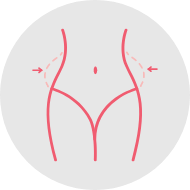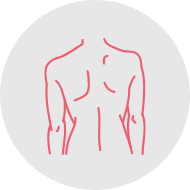Body Lift Toowoomba
Procedures
Body Lift (Belt Lipectomy)
Significant weight changes can affect the skin and underlying tissue, sometimes leading to skin folds and reduced elasticity in areas such as the abdomen and upper thighs.
A body lift is a surgical procedure that may address these changes by removing excess tissue and repositioning the remaining skin to support the area’s structure. Medicare rebates may be available when the procedure is considered medically necessary, and some private health funds may provide additional support.
At Allure Clinic in Toowoomba, an individual assessment is conducted to determine the most appropriate treatment plan for each patient.
Treatment Outcomes

May address excess tissue in the abdominal area

May support abdominal wall function and movement

May assist with symptoms related to skin folds or tissue changes
FREQUENTLY ASKED QUESTIONS
What happens during a body lift?
A body lift may include procedures that address the upper and lower abdomen, buttocks, hips, and thighs. Incisions are made in areas such as the upper or lower abdomen, waistline, and sometimes the inner thighs, depending on the areas being treated. These are planned to reduce the visibility of scarring where possible.
Excess skin and tissue are removed, and the remaining skin is repositioned to support the area. The incisions are closed with sutures, and a compression garment is typically used as part of the aftercare plan. In some cases, abdominal muscle repair is included to address changes in the abdominal region.
What to expect after a body lift?
After surgery, dressings are placed over the incisions, and temporary drains may be used to assist with fluid removal. These are usually taken out within a few days. Recovery experiences vary, and a gradual return to daily activities is advised based on individual progress.
During the early recovery from a lower bodylift, it is recommended that patients avoid long periods of sitting to reduce tension on the incision lines above the buttocks. Driving is not advised until at least two weeks after a lower bodylift.
Swelling, bruising, numbness, and discomfort are common during early recovery. Light walking is often recommended to support circulation, while more strenuous activities are generally postponed for several weeks. Postoperative care instructions are provided, including guidance on wearing compression garments.
What results may be expected from a body lift?
Changes in the treated areas may be noticeable once swelling reduces. It can take several months for tissues to settle, and the final appearance may continue to develop during this time. Results vary depending on factors such as the patient’s healing response and the extent of the procedure.
What are the possible risks and complications?
A body lift is a surgical procedure and carries risks. These may include:
- Bleeding
- Infection
- Bruising
- Fluid accumulation (seroma)
- Delayed wound healing
- Poor scarring or changes in scar appearance
- Numbness or altered skin sensation
- Asymmetry or contour irregularities
- Need for further surgery (for complications or revision purposes)
These risks are discussed in detail during the consultation. Patients are encouraged to provide a full medical history and list of medications to assist with a thorough assessment.
What aftercare is required?
Patients are provided with specific instructions to support recovery. This may include caring for incision sites, using compression garments, avoiding heat exposure, and attending follow-up appointments. Gentle walking is generally encouraged, but heavy lifting and exercise should be avoided until advised. Any unusual symptoms or concerns during recovery should be reported to the clinic promptly.
Smoking cessation is required for at least six weeks prior to undergoing a bodylift, and for at least six weeks following.

